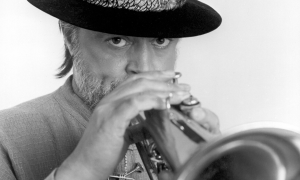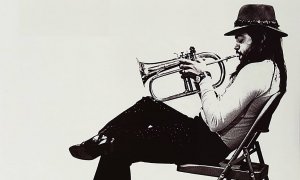Home » Jazz Articles » Catching Up With » Steffen Basho-Junghans: Guitar Excursions into the Unknown
Steffen Basho-Junghans: Guitar Excursions into the Unknown

Courtesy Blue Moment Arts
In the more 'experimental' works I dive into the space created by the guitar and have the feeling that the sounds seem to come from all sides around me. Where they meet, elements emerge, which are then put together. When you 'go out' again, 'zoom out' so to speak, you then understand this as music.
All About Jazz: Your new album Dancer on the Hill comes out more than 10 years after the previous one, IS, which was published in 2009. Why was there such a long gap between recordings, after an intense discographic activity during the previous 10 years?
Steffen Basho-Junghans: After 2009 pieces of mine were again on several sampler albums, but for a long time I couldn't find a label for an album release. I already had some more almost finished album projects. Then a cancer diagnosis in 2016 changed my life completely and it took quite a while until I was able and willing to be creative again. Then also the release of the current album took longer than I thought.
AAJ: Some of the pieces in the new album seem to follow a South American theme, echoed in titles as "Raga Peru," "Brazil" and "Song of the Cordilleres," while the guitar sounds sometimes like a charango. Is this actually a new landscape in your musical geography?
SBJ: This is not really a new part in my music for me, some of the pieces were already written in the late '90s, the other from the early 2000s. So the music of South America has been on my mind for a long time, because I am always interested also in the rhythmic elements. I always wondered why the so-called "Americana"-scene looked a lot to the Orient or Asia, but hardly to South America, maybe it had something to do with other rhythmic structures.
AAJ: You were one of the first guitar players to incorporate elements of Robbie Basho's music and instrumental technique into your own music since the early 90's, soon followed by others like Glenn Jones, Jack Rose, James Blackshaw, Buck Curran, Kyle Fosburgh, all contributing to keep his memory alive. What is in your opinion the most important legacy from Robbie Basho that is reflected in your own music, and to contemporary guitar in general?
SBJ: An important element of Basho's influence is certainly that it is not always superficially about perfecting the playing technique, but that music has to say something about the diversity of life, cultures, landscapes etc. "Soul first, technique later!"
AAJ: When Basho died in 1986 he was virtually unknown to his contemporaries, without even having a record deal. Today, his influence and importance are acknowledged by many guitarists, many of his albums have been reissued, tribute albums are published, a documentary on his life has been produced and screened and is now available on DVD. What do you think is the reason behind this revival?
SBJ: It was also in the mid '90s, when my journey into Robbie Basho's history became so intense, that he was almost completely forgotten at that time. The answers to my many questions back then usually started with an "oh, my goodness, it's such a long time ago...," but gradually the stone began to roll. Maybe my Robbie Basho online archive (since 2000) and my first publication in the USA (2001) did a little bit to bring his name back to memory, maybe. Then the distribution of information via the internet became more and more important. After a few first re-releases, it was important that a young generation started to discover him, like Liam Barker who made the documentary, for example. Since a few years I have the feeling that many people wanted to jump on and that the boom of rediscovery became more and more intense. At times you could even see that something new was always expected, though news was just published. And I also had to see, that nearly nobody came to let the online archives grow.
AAJ: Your music has always been following two distinct paths, one more "classical" often using the american raga form in the way Robbie Basho used it, that we can hear in albums like Song of the Earth (Sublingual Records, 2000) or Rivers and Bridges (Strange Attractors, 2003), and on more experimental recordings where you explore more freely the guitar soundspace, expressed in albums like Inside (Strange Attractors, 2001), Landscapes in Exile (Blue Moments Arts, 2001) and Unknown Music (Sillyboy/Preservation, 2005). With your latest albums, it seems that the two paths have unified and now the sound explorations come from the more structured pieces. Is this the way your music has evolved?
SBJ: In the beginning my music was strongly influenced by the Takoma guitarists, not only by Basho's american raga form, and step by step also by other influences, because I have always heard a wide range of music. With my age I have a slightly different musical background than the younger "guard," many of whom discovered the '60s for the first time and wanted to sound like them. So the more experimental approach is logical, since I have also been listening to electronic, experimental, contemporary music or jazz since the early '70s. The crucial point, that this is not just something to "experiment" with, came when I had to completely re-string one of my 12 strings after a repair and suddenly, before I wanted to tune the chaos, the idea was there to experiment with it, to see if something interesting is possible with that "chaos" and I recorded the whole thing. The result was my "Virgin Orchestra No1." This completely broadened my perspective on how I can work with the guitar. In a way, it was still the same "garden," but I entered it through a different gate. It is always a matter of perspective. The Landscape in Exile CD was the next result of this development and was a preparation for the albums like Inside, Waters in Azure, 7 Books... After 7 Books I realized that both sides belong to my music, even if some projects or pieces sometimes go more in one or the other direction. And that's how I arranged my concerts from that point.
AAJ: What is your normal approach to composing music? Do you have some specific routine for that? Is it different between 6 and 12-string guitars?
SBJ: On the one hand (the more "classical" pieces), interesting partial passages, ideas emerge, which I sometimes keep in my head for weeks and process further, and on a good day they suddenly fit into the whole with still missing elements. On the other hand, I spin around with the guitar, listen to the sound developments and small nuances that arise and from that whole pieces develop. Pieces such as those on Inside were developed from a simple idea at the beginning in one go. Certainly through the whole spectrum of music that I have ever heard there is a huge archive of sounds, patterns, elements etc. in my head, often also in the subconscious. I then simply let the "things" run, only to discover afterwards where I "have been." It's like opening the door and start walking. It's diferent between 6 and 12 string guitars, because both have their special character and offer different possibilities.
AAJ: Your compositions, like Basho's, have often been described as musical paintings or soundscapes, also reflecting the fact that you're a painter in addition to being a musician. However, I think they rather resemble sound sculptures, in particular your more experimental records, because they explore the sound space with a strong sense of depth, almost three-dimensional. Do you also feel this way?
SBJ: Everything is space, including sounds and elements and in my perception everything, every place, every living being, so also every human being has its own sound, which I then explore. In the more "experimental" works I dive into the space created by the guitar and have the feeling that the sounds seem to come from all sides around me. Where they meet, elements emerge, which are then put together. When you "go out" again, "zoom out" so to speak, you then understand this as music. I describe, for example, my freer graphic works as two-dimensional "imprints" of these experiences. As a young boy I had special experiences: While I was sitting in our garden at the end of the village, I heard the train behind the hill from time to time, in the neighboring village a dog was barking, around me the birds and the wind rustling, beside me sounds from a small radio, and in the background the buzzing sounds of the potash plant behind our garden could be heard. I think these moments were my first sound-space experiences. This combination of natural and industrial sounds left a formative impression.
AAJ: For many acoustic guitar players finding a label for releasing recordings of their music has always proved to be a major challenge. Your discography is scattered over several different small independent labels. However, Strange Attractors published 5 of your albums between 2001 and 2006, weren't they interested to continue the collaboration? In general, what has been your relationship with all those labels?
SBJ: Due to the attention my albums at Sublingual and Strange Attractors had received, the requests came from that other labels for the release of an album. The cooperation was actually really good with almost all of them. There were a few discussions with Strange Attractors, for example about a tour cancellation, but I hadn't been informed about that. Probably I became too "exhausting" for the label, I don't know. Anyway, the contact broke off sometime after the last album. Chris Scofield [founder of Strange Attractors label] contacted me again a while later. A producer wanted to use a part of my music for a nature documentary hosted by Robert Redford and I let him take care of the arrangements. I never heard anything about it again after that and also my inquiries were never answered by the label. Furthermore I hadn't received any sales invoices since 2004. So much for that.
AAJ: For many years on your website Bluemomentarts.de you have been announcing a 3,5 hour-work "The Virgin Orchestra No.1" for a never -tuned 12-string guitar as being in preparation for release as a 3-CD set. So far, however, only an 8 minute extract has surfaced on 156 Strings [Cuneiform Records, 2014}, a compilation CD by several acoustic guitarists. Will the full work ever be published? Do you have other unreleased works?
SBJ: Yes, the "Virgin Orchestra No 1..." Many years ago a Swedish label seemed interested in releasing it, but unfortunately came back to that idea and I am still looking for a label that would have the courage to do so, because there are so many different and beautiful moments to discover inside. Yes, I have other unreleased album projects, such as "The 1st Light," a project from the recording sessions for 7 Books (kind of episode no 1 before 7 Books...) and another crazy 12-string project has been added. I had noticed that I still had a wonderful tuning on a 12-string, my "Ocean Waves" tuning. So I started improvising and after 2 weeks I suddenly had 4 hours of material and the idea for "Books of Water." Crazy enough, I tuned another 12-string in the same way and suddenly I had another 3 hours of material. Now I am busy since that time sorting out what is good, what is not so good, what fits and in what order. Just crazy...
AAJ: What are your future plans, considering that this year's unprecedented pandemic event has caused big problems to many sectors in the global economy, one of which being the performing arts sector? Do you see a way out of this serious situation?
SBJ: My plans for the future are very manageable at the moment, because besides the problematic corona situation, this year was really not an easy year because of therapies for my cancer. At the moment I have to deal again with some side effects. But I hope that maybe in the 2nd half of 2021 live performances will be possible again, always with the background that my health situation will allow it. Otherwise I will continue to work on my archive of recordings and record new ideas. At the moment an exhibition is planned for March here in Berlin, combined with 3 concerts.
Afterwards, AAJ posed a few questions to Harry Wheeler, founder of the British label Architects of Harmonic Rooms, who released the two latest albums of the guitarist.
AAJ: Why is the album only available as a vinyl or a digital download, like its predecessor? Do you think that the CD format is no longer a profitable medium for this kind of niche music?
Harry Wheeler: We're a small label with limited resources and I liked the idea of going for the two extremes. Steffen's music has a certain intensity and it's important to meet that intensity whilst listening. Whether that's via the sacred modern ritual of placing vinyl on a turntable or the intimacy of listening through headphones while you're walking alone in the forest. At the time of releasing IS the digital format was just taking off and we did wonder if CDs would be around in 2020, however time has told that the further we we drift off into cyberspace the more important the physical becomes. Like astronauts staring at the earth craving to run their hands through the fields of grass below. Here we are in 2020 and CDs seem to be going strong. One bonus aspect of CDs is that they are easy for performers to carry around whilst on tour (which because of the lack of gigs is sadly not much use in 2020). I'm told CDs are especially popular in Japan. Another thing that time has taught us is that the CD format can degrade, although we're not against them and might well do a CD release in the future, ultimately given the choice we felt that Steffen's music deserved to sit on the vinyl throne.
AAJ: How did you get involved with Steffen and decide to publish his music?
HW: I was helping out my friends who put shows on in Sheffield in the mid '000s and they put Steffen on. I wasn't too familiar with the whole finger picking scene back then, but his performance and his general character got my attention. He came across more like an elemental force than a human and not only that, he seemed to have the uncanny ability to direct elemental forces out of his guitar strings. I put him on in Leeds and helped organise a few tours in the UK. I remember his guitar was lying in its open case in my front room and he was sitting next to it, staring at the strings and gently plucking them while the sun shone through the window and noted how it sounded like warm sunshine.
AAJ: Do you have plans to release other artists' music on your label, or is it a sort of "private label" for Steffen?
HW: There are many gifts that COVID-19 has given me over 2020 and one of them is the reminder of importance of living in the now. The reminder that death is all around, helps to motivate oneself to get that bucket list ticked off. Steffen's music takes the listener into different states of being. Just like the ragas of India which are composed for different times of the day or transitions of the seasons, the compositions contains very specific ways of being. The future goal for the label is to put out music which is: 'Dedicated to conscious expanding S O U N D S.' That might well sound pretentious to some, but just like Robbie Basho I really mean it. We're working on a couple of releases from other artists now and at least one should come out in 2021.
Tags
PREVIOUS / NEXT
Support All About Jazz
 All About Jazz has been a pillar of jazz since 1995, championing it as an art form and, more importantly, supporting the musicians who make it. Our enduring commitment has made "AAJ" one of the most culturally important websites of its kind, read by hundreds of thousands of fans, musicians and industry figures every month.
All About Jazz has been a pillar of jazz since 1995, championing it as an art form and, more importantly, supporting the musicians who make it. Our enduring commitment has made "AAJ" one of the most culturally important websites of its kind, read by hundreds of thousands of fans, musicians and industry figures every month.





















